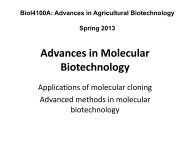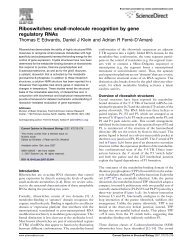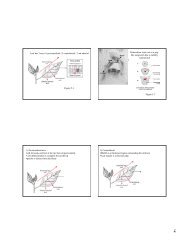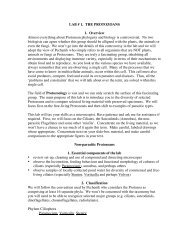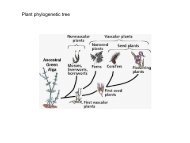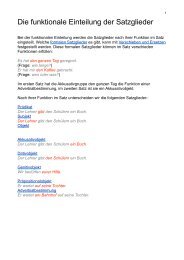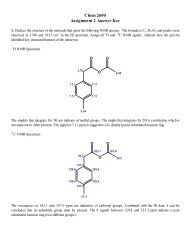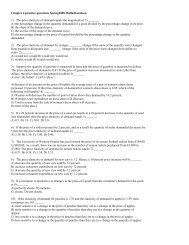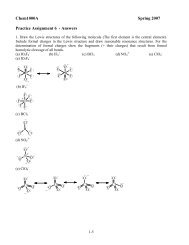Lecture 16-Rotifers.pdf - Classes at U. of L.
Lecture 16-Rotifers.pdf - Classes at U. of L.
Lecture 16-Rotifers.pdf - Classes at U. of L.
You also want an ePaper? Increase the reach of your titles
YUMPU automatically turns print PDFs into web optimized ePapers that Google loves.
Phylum Rotifera—”wheel bearers”<br />
•Microscopic(2000 spp.<br />
•Bil<strong>at</strong>eral symmetrical pseudocoelom<strong>at</strong>es<br />
•Body somewh<strong>at</strong> cylilndrical with an anterior cili<strong>at</strong>ed disc (corona) and a posterior<br />
forked tail (foot)<br />
•Body covered with a cuticle th<strong>at</strong> is sometimes modified into a hardened shell-like<br />
cover (lorica)<br />
•Digestive tract usually complete with a mouth, pharynx, stomach, intestine and<br />
an anus.<br />
•Pharynx equipped with movable jaws (mastax, trophi) usually for grinding up<br />
algae<br />
•No obvious eyes or other sense organs.<br />
•Parthenogenesis common, males unknown in many species, about 1500 species<br />
•Mostly freshw<strong>at</strong>er species—believed to have origin<strong>at</strong>ed in FW—common in the<br />
plankton <strong>of</strong> lakes, and living on plants and <strong>at</strong>tached algae as well in both lakes<br />
and streams.<br />
•Exhibit eutely—body has a constant number (about 1000) <strong>of</strong> cells, th<strong>at</strong> grow in<br />
size as the animal grows larger.
An<strong>at</strong>omy <strong>of</strong> Euchlanis—a planktonic rotifer<br />
Corona<br />
Nephridia—flame cells<br />
Gastric glands<br />
foot<br />
mastax<br />
Trophi (2)<br />
toe<br />
Urinary bladder<br />
oviduct<br />
intestine<br />
Vitelline gland<br />
stomach
Close-up <strong>of</strong> the jaws-trophi <strong>of</strong> a rotifer<br />
Key:<br />
F fulcrum; M<br />
manubrium; R<br />
ramus; U uncus.<br />
Once food is captured by the corona it passes into a mouth and a muscular pharynx called the<br />
mastax, which is equipped with a set <strong>of</strong> grinding jaws called the trophi. The ground up food is<br />
then passed on to the esophagus and stomach.
Class Bdelloidea—means “leech like”<br />
Body large (> 0.3 mm) elong<strong>at</strong>e, s<strong>of</strong>t bodied forms,<br />
creeping worm-like movement, with no lorica, head<br />
and food flexible and retractile, creeping forms<br />
benthic or epiphytic, foot with two toes, paired<br />
ovaries, corona with two circular lobes<br />
Sex is unknown in bdelloids, only parthenogenetic<br />
females exist, > 300 known species<br />
They are one <strong>of</strong> the most ancient asexual lineages<br />
(<strong>at</strong> least 40 million years)<br />
Many are capable <strong>of</strong> cryptobiosis<br />
Corona, two<br />
circular lobes<br />
paired ovaries<br />
Philodina—mid-section distinct from tail section<br />
Philodina
Closeup <strong>of</strong> the ram<strong>at</strong>e mastax <strong>of</strong><br />
Philodina<br />
trophi <strong>of</strong> mastax<br />
Ram<strong>at</strong>e mastax—semicircular rami with large grinding teeth<br />
http://bios.sakura.ne.jp/gf/2004/ro<br />
http://www.environmentalleverage.com/bug%20<strong>of</strong>%20the%20month/rotifer%20for%20web/rotifer2.jpg
Single ovary with one egg<br />
A rotifer carrying a single<br />
egg <strong>at</strong>tached to its body<br />
Lorica—shield-like ‘shell’<br />
sometimes with spines<br />
Class Monogononta—”single ovary”<br />
•Benthic, free swimming, or sessile forms,<br />
•lorica present or absent,<br />
•foot present or absent-toes variable,<br />
•corona usually a single cili<strong>at</strong>ed disk ringing the anterior end,<br />
•mastax not ram<strong>at</strong>e<br />
‣<strong>16</strong>00 species, mostly dioecious altern<strong>at</strong>ing between parthenogenesis and sex<br />
‣Males are usually small, with a vestigial gut, and only for sex
The Monogonont life cycle<br />
Usually while food and survival conditions<br />
are quite good most <strong>of</strong> the popul<strong>at</strong>ion are<br />
females which produce diploid eggs th<strong>at</strong><br />
h<strong>at</strong>ch to make identical copies <strong>of</strong> the<br />
female parent.<br />
During autumn the stimulus to undergo<br />
meiosis, and make haploid (mictic) eggs<br />
occurs, then if those eggs don’t get<br />
fertilized they h<strong>at</strong>ch out as males.<br />
Males will then seek out mictic females<br />
and have sex with them. The eggs<br />
produced are larger and contain more<br />
nutritional reserves than normal<br />
parthenogenetic eggs, and delay<br />
h<strong>at</strong>ching <strong>of</strong>ten till the following spring or<br />
when suitable conditions occur.<br />
Some females can do both-Amphoteric<br />
Pseudosexual eggs—parthenogenetic<br />
eggs th<strong>at</strong> look like resting eggs have been<br />
noted in some species.
Critical food popul<strong>at</strong>ions for popul<strong>at</strong>ion growth <strong>of</strong> different rotifers.<br />
Kc=Ker<strong>at</strong>ella cochlearis, Ke=K. earlinae, Kcr=K.crassa, So=Synchaeta oblong<strong>at</strong>a<br />
Sp=Synchaeta pectin<strong>at</strong>a,Bc=Brachionus calyciflorus, Pr=Polyarthra rem<strong>at</strong>a,<br />
Ap=Asplanchna priodonta. (From Stemberger and Gilbert 1985)
Lorica with anterior and posterior projecting spines, foot present--Brachionus
Lorica divided into plaques, 6 anterior spines and 1 or 2 posterior spines, foot<br />
absent--Ker<strong>at</strong>ella<br />
The length <strong>of</strong> rotifer spines increase during the summer months (cyclomorphosis), and<br />
they are generally though <strong>of</strong> as anti-pred<strong>at</strong>or devices and projections th<strong>at</strong> slow sinking
lorica with 3 very long anterior projecting spines and one long<br />
posteriorly projecting spine-- Kellicottia<br />
Female Kellicotia releasing an egg<br />
The length <strong>of</strong> rotifer spines increase during the summer months (cyclomorphosis), and<br />
they are generally though <strong>of</strong> as anti-pred<strong>at</strong>or devices and projections th<strong>at</strong> reduce<br />
sinking r<strong>at</strong>e.
om Stemberger 1988
Wh<strong>at</strong> conditions are good for rotifers?
1 mm<br />
Asplanchna—large pred<strong>at</strong>ory species<br />
(> 1mm) sac-like body shape,quite<br />
transparent,<br />
Corona a single circumapical ring <strong>of</strong><br />
cilia, no lorica, foot present or absent,<br />
but never distinct foot with separ<strong>at</strong>ed<br />
toes, intestine and anus lacking
The incud<strong>at</strong>e trophi <strong>of</strong> Asplanchna priodonta—rami shaped as jaw-like pincers<br />
http://users.unimi.it/melone/trophi/start.html
Family Synchaetidae—Synchaeta, most marine/estuarine species in this family<br />
no lorica, foot present, anterior region wide, with 4 stiff anterior styles—




